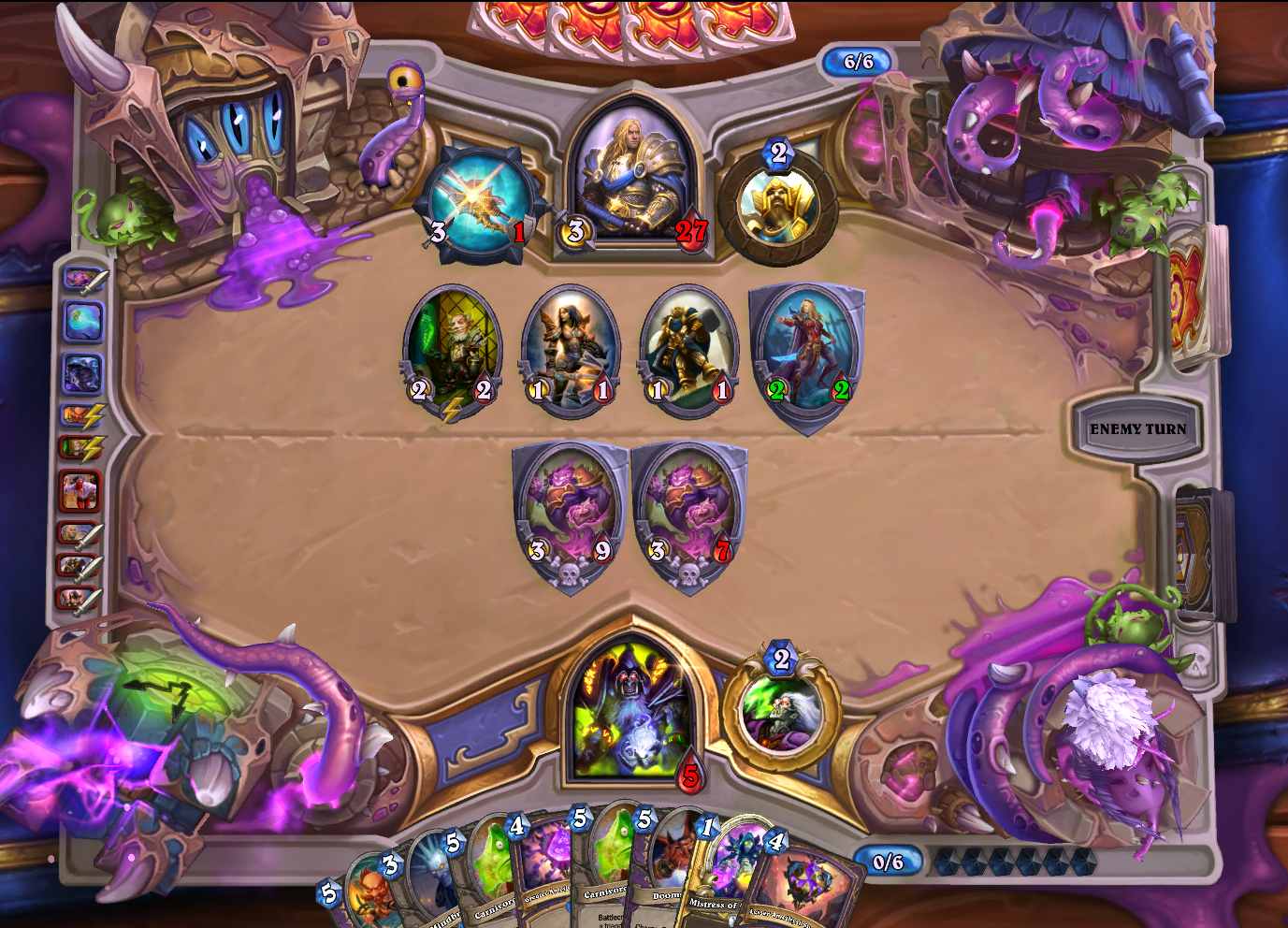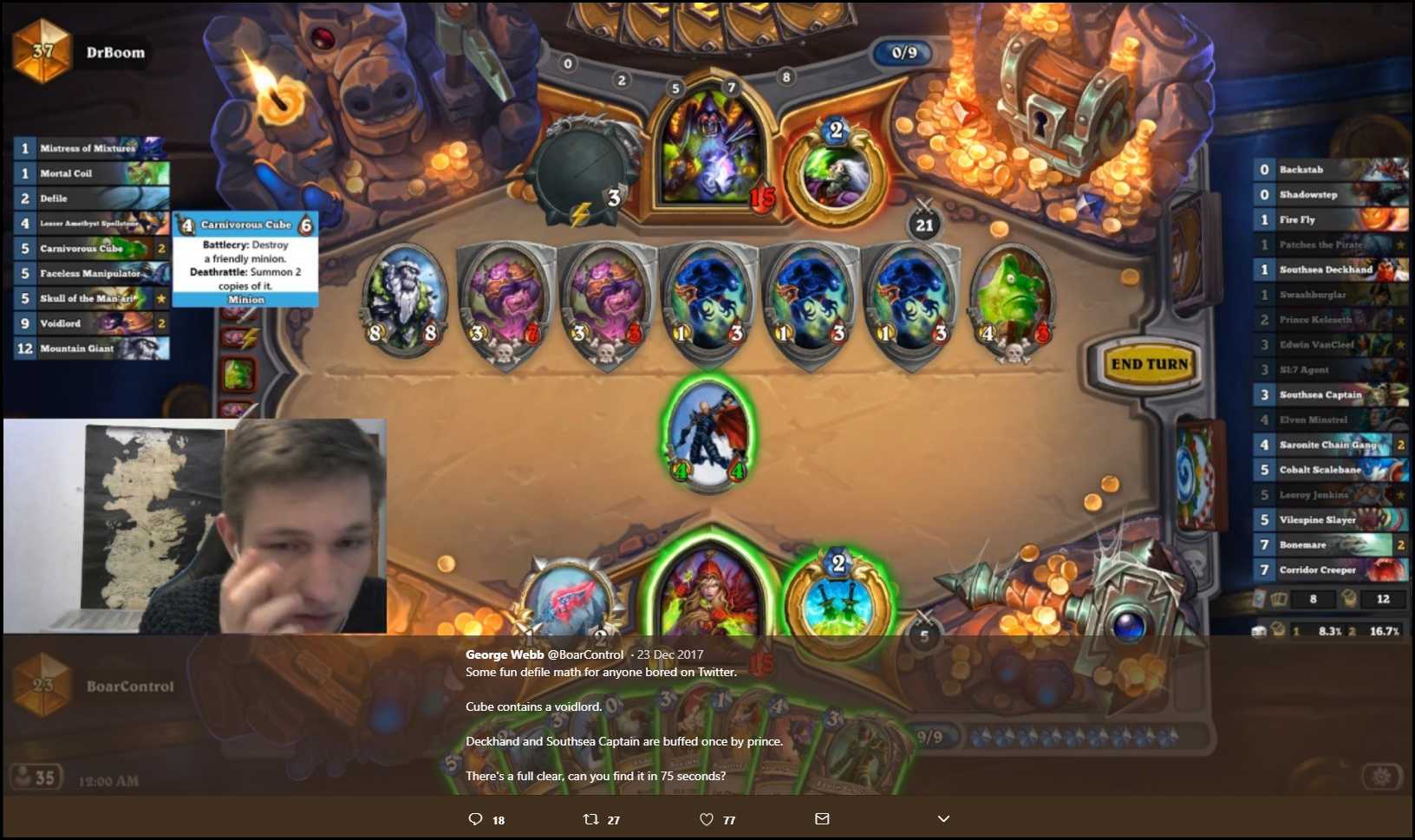Silence or Bust: How Cubelock Slowed the Hearthstone Meta
“This card could potentially just shape the meta game,” Firebat mused about Carnivorous Cube in the Omnistone Kobolds and Catacombs set review. “Everyone’s deck might just be required to be fast enough to kill you so that you can’t play this.”
At the time I thought his take, echoed by Kibler and Zalae, verged on hyperbolic. I was wrong.
While the meta has slowed rather than sped up, we can attribute that change in pace to what Carnivorous Cube has done to the Warlock class, improving Control Warlock’s match-ups with other control decks while maintaining a suite of anti-aggro cards. Cubelock forces fast decks — Aggro Paladin, Tempo Rogue, Face Hunter, Burn Mage — to race to a finish before turns five and six, hoping to defy odds and dodge a devastating Defile or Hellfire along the way.
These fast decks are still viable, and Razakus Priest still dominates, but Firebat was right: Carnivorous Cube has helped to shape the Kobolds and Catacombs meta as we know it, spawning an archetype and a whole lot of Spellbreakers. Cubelock is the new control-combo hybrid archetype borne out of the Cube’s powerful interactions with a few cards. The deck has tools to stifle aggro, out-value control, and sometimes charge down Razakus Priest — and the Cube plays a large part in all of those win conditions.
We Dare Summon Doomguard
In general, the gameplan is to draw cards early and set up for massive swings in both health and tempo with combinations of Possessed Lackey, Skull of the Man'ari, Doomguard, Voidlord, Carnivorous Cube, and Dark Pact. The specific combination you’re aiming for depends on the match-up. Against an aggro opponent without access to a silence effect, Voidlord ends games; Dark Pact on a Cube or Lackey helps you stall to get there, as does Defile, Hellfire, and Mistress of Mixtures.
Against control decks, some versions of the deck can threaten 25 points of damage in a turn. The combo is as follows: cheat a Doomguard onto the board with Skull of the Man'ari or Possessed Lackey, hit the opponent’s face, play Spiritsinger Umbra, eat the Doomguard with Carnivorous Cube, hit face for 10 more damage, and finally use Dark Pact on the Cube to deal another 10. Sure, it’s a fringe, multi-card combo, but the deck has the tools to draw cards and stall to consistently threaten such a play. Bloodreaver Gul'dan then threatens all that damage over again — this time from one card.

But the combo is not an imperative. As with the old Renolock combo — a discounted Leeroy Jenkins, Faceless Manipulator, and Power Overwhelming — it’s merely an option. More than that, it’s a possibility that sends your opponent into a panic. A tempo Spiritsinger Umbra on turn 4, for example, can be played to bait out a silence effect and clear the way for Possessed Lackey, your much more consistent value card. Zalae’s list, which we’ve featured, uses Prince Taldaram and two Dark Pact to push the same amount of damage in the late-game. The flexibility of Prince Taldaram arguably makes it the better version, at least while valuable Deathrattle, Taunt, and Divine Shield minions roam the meta.
A Misplay, or Three
All that said, there are significant difficulties in playing the archetype. Chief among them: it is very, very difficult to assess optimal lines of play against control decks — especially with a clunky hand of incomplete combo pieces. Successful players will need to carefully consider the odds of drawing key cards while using life tap and monitoring their health. They will need to consider sub-optimal tempo plays against aggro and the odds and opportunity cost of jamming a Doomguard onto the board. And they will, in all likelihood, need to draw Mountain Giant early against Razakus Priest.
Also, there’s a little card called Defile. One of the most efficient removal cards in the game happens to be often one of the most complicated. Last month pro player and streamer BoarControl shared with his Twitter followers a screenshot of a full board of minions, offering that there was indeed a full board clear available. These math puzzles are a lot to contemplate in a 75-second turn, so cheers to anyone who can find the clear so quickly. (He didn't.)

Now and Ahead
Competitive circles haven’t yet settled on one list, but many are gravitating toward Zalae’s, which features two copies of both Mountain Giant and Faceless Manipulator to threaten damage versus Priest before their Psychic Scream and Shadowreaper Anduin turns on 7 and 8. Mulligan hard for the giants in this match-up, along with Skull of the Man'ari. If the meta quickens, you can reinforce Cubelock’s dominant position by trading the giants for two Plated Beetle. Against aggro, mulligan for Mistress of Mixtures, Kobold Librarian, Defile, Mortal Coil, and Hellfire — you have many options.
In a month, Cubelock has proven itself a powerful and rewarding, albeit challenging, new archetype. Against aggressive decks, it dominates. Versus control, it is at least viable — and Zalae’s innovative list has made the match-up with Razakus Priest, far-and-away most powerful and popular standard deck, a winnable one. Going forward, expect decklists to change often, sometimes by a lot, as we all learn how to pilot it optimally. And barring a nerf (or two), I predict you would do well to practice playing both with and against it — because after the first expansion of 2018 goes live, Razakus Priest will lose Raza the Chained to Wild and become unviable, while Cubelock loses only Mistress of Mixtures.
Minion (20)
Ability (8)
Weapon (1)
Playable Hero (1)
Loading Collection


-
View User Profile
-
Send Message
Posted Feb 1, 2018 (Kobolds Patch)Cube is so strong
-
View User Profile
-
Send Message
Posted Jan 11, 2018 (Kobolds Patch)Is there any way to beat this deck?
-
View User Profile
-
Send Message
Posted Jan 17, 2018 (Kobolds Patch)Highlander Priest does well against it. Two Spellbreaker in Zoolock or Aggro Paladin worked for me last month.
-
View User Profile
-
Send Message
Posted Jan 19, 2018 (Kobolds Patch)Best of luck!
-
View User Profile
-
Send Message
Posted Jan 10, 2018 (Kobolds Patch)my cubelockop
-
View User Profile
-
Send Message
Posted Jan 10, 2018 (Kobolds Patch)ridiculous card...
-
View User Profile
-
Send Message
Posted Jan 7, 2018 (Kobolds Patch)It's so funny that the "worst" legendary weapon is the one seeing the most play. I love hearthstone LUL
-
View User Profile
-
Send Message
Posted Jan 7, 2018 (Kobolds Patch)-
View User Profile
-
Send Message
Posted Jan 7, 2018 (Kobolds Patch)-
View User Profile
-
Send Message
Posted Jan 8, 2018 (Kobolds Patch)-
View User Profile
-
Send Message
Posted Jan 8, 2018 (Kobolds Patch)I've heard this complaint many times playing many different games (M:tG, WoW, Lot5R, YGO, etc.). The fact is, net decking is so easy to do and is supported for any CCG that comes into popularity where there is a competitive environment. HearthPwn itself supports net decking. How does Blizzard (or anyone else) solve this problem while retaining the ability to roll your own decks?
I would argue that Hearthstone does this better than most by having multiple decks in multiple classes in vogue at any one time. Some of the CCGs have historically been able to only support one real winner and everything else in the meta was the antithesis. Since playing CCGs has gone online, it has only gotten worse. It used to be that you could go to a regional tournament and still see the oddball deck do fairly well, although it was widely recognized that the favorite net deck(s) would still be at the top. I attended a national YGO tournament in Columbus a number of years ago where almost every single deck out of the field of hundreds was the exact same deck which had only been revealed a day or two prior.
Bottom Line: This isn't something Ben or anyone else can do anything about. If you don't like people net decking then don't play a CCG competitively. Play for fun, or enjoy other aspects of the game (arena, dungeon runs, etc.). Unless you are a pro (i.e., you get PAID to play these things based on your performance), does it really matter?
Just my opinion, for what it is worth (not much).
-
View User Profile
-
Send Message
Posted Jan 9, 2018 (Kobolds Patch)Agree with prior poster. It would be nice to see deck diversity however when you bring a CCG to the online environment, the most optimal decks are much more likely to rise to the top and do so much faster. Games go faster online rather than IRL so you have many, many more total games. More games means more data and more deck refinement and the fact that the player pool is gigantic means the decks that are performing well will gain exposure and good players are likely to emulate them. I don't see it as a bad thing, it's just the nature of the online environment. I'm actually surprised by the amount of deck diversity considering the circumstances.
-
View User Profile
-
Send Message
Posted Jan 9, 2018 (Kobolds Patch)-
View User Profile
-
Send Message
Posted Jan 9, 2018 (Kobolds Patch)You might as well be advocating against the internet itself.
-
View User Profile
-
Send Message
Posted Jan 9, 2018 (Kobolds Patch)-
View User Profile
-
Send Message
Posted Jan 7, 2018 (Kobolds Patch)I love this new warlock control decks, everyone is playing some sort of cubelock in wild... i play mill rogue Kappa
-
View User Profile
-
Send Message
Posted Jan 8, 2018 (Kobolds Patch)Lol
All 4 mill rogues what I meet between 7-9 on my Cubelock in Wild hears "Fear me" and died.
This game is a coin flip. You have a good chance for lose in every battle and in a preferred matchups, too.
-
View User Profile
-
Send Message
Posted Jan 7, 2018 (Kobolds Patch)Here is one way to clear the BoarControl Defile Puzzle: (Explanations below)
Doing this leaves you with the following counts:
Rationale/ Thought Process/ Explained
Consider deathrattle cards as their HP + the HP of whatever they spawn for Defile math (i.e. 3/9 Voidlord counts as 9 and 12 since it spawns 3 HP Voidwalkers. The current board state has a max HP of 15, and you're missing the HP of 9, 11, 13, 14. (10 is from 3/7 Voidlord and 12 is from 3/9 Voidlord in the Cube)
The Cube should die before Defile is played
You need 4 Mana to break Cube
Bring down board HP by Damaging Voidlords to get missing numbers
TL:DR - Keleseth OP. +1/+1 buff enabled a full board clear /s.
-
View User Profile
-
Send Message
Posted Jan 7, 2018 (Kobolds Patch)I dont see the big deal about this deck; according to Vicious Syndicate, the largest threat in the game is still Tempo Rogue, and it has been so since the nerf to Innervate and Fiery War Axe. Imo THAT is the deck to be beaten and be salty about. Cubelock has strengths and weaknesses, but its perceived power is larger than its real power, thats why people are teching against it instead of their respective counters (looking at you, Aggro Paladin)
-
View User Profile
-
Send Message
Posted Jan 8, 2018 (Kobolds Patch)Turns out Cubelock is a hard deck to play